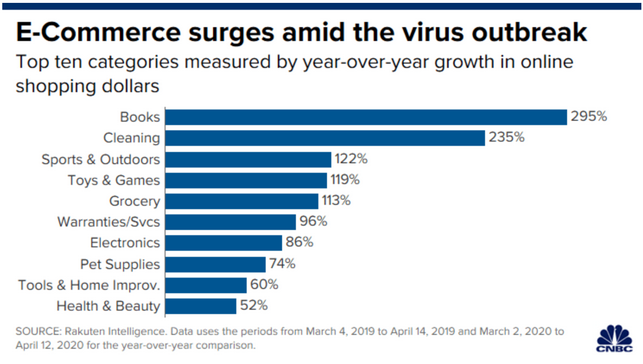At this point, it is safe to say that COVID-19 has changed the world. With working from home and social distancing looking like it could become the “new normal”, where do we go from here as marketers? Once the world has reopened, what changes will be permanent? Which tactics are going by the wayside and which are becoming more critical to the survival of your company? These are questions that many business owners, professional marketers, and executives are asking themselves. While there are no real answers and a lot of opinions, it is paramount to look at what the data is showing us.

Virtual Is Now The Global Standard
According to the American Marketing Association, the shift to digital has been underway for years. Now, with an increased amount of connected devices and easier access to the internet, people are able to tap into the virtual world in a way we have never seen before. What coronavirus has done is accelerated the transition to some digital spaces. By forcing us into our homes, this has pushed consumers to rapidly change their behaviors overnight whereas normal adaptation rates build to a peak and then fall as the behavior becomes the standard.
An example of this adaption of living in a digital world is online shopping, which saw a huge surge of 55% across the globe at the start of the pandemic, according to a study conducted by Astound Commerce. In toys specifically, Rakuten Intelligence found a 119% surge in e-commerce sales and a 122% jump in sporting good and outdoor products. Another industry showing strong growth in online sales are grocery stores, with the number of households ordering groceries online is up 145.3% in the US when compared to August 2019 according to a consumer survey from Brick Meets Click, food marketing and sales consulting firm. A roughly quarter of participants in the survey indicated that this was the first time they had done so and that jumps to 39% for shoppers 60 and older.
Other examples outside of e-commerce are a massive leap in online collaboration tools and a huge drop in paid-TV subscriptions. For online collaboration tools, Microsoft’s Teams gained more than 12 million daily users in one week and Slack saw an increase of 2.5 million users due mainly to people working from home. For paid-TV subscriptions (cable and satellite), Variety is reported, there has been “an explosion in cord-cutting”, with an overall drop of 1.8 million subscribers in the first quarter of 2020 because of a combination of current economic pressures and the loss of live sporting events.

Image Source: Rakuten Intelligence through CNBC
Is this Permanent? What Does a Post-Pandemic Consumer Look Like?
Now figuring out what changes will be permanent is incredibly difficult but a large percentage (42%) of consumers believe the way they shop has fundamentally changed, so what will those “changes” look like?
With a massive surge in online shopping, we can expect consumers to be more comfortable with going online for a range of reasons. This could include researching what they are planning on buying in-store to comparing prices to purchasing online. These new digital consumers will be looking to take full advantage of omnichannel retailers who have a well-integrated in-store and online experience. In the short term, this combined with high-demand on specific products and 65% of consumers facing out-of-stock issues during the pandemic, it is expected that buyers will be more comfortable ordering from merchants they are less familiar with (25% of consumers have already done so) – this creates an opportunity for manufacturers to go directly to their customers.
What Does This Mean For Marketers?
For marketers, the biggest challenge that we are facing is that this is an evolving situation and there will be lasting impacts beyond shopping and viewing habits that we can’t predict. This may mean that we can no longer depend on some of the tried and true tactics that have become the default over our careers but instead need to rethink how we approach planning and pay close attention to what the data is telling us. Based on the current information that we have available to us, some changes that we can predict are:
Focusing on E-Commerce:
- There will be an increase in focus on improving the e-commerce experience for retailers (and integrated into the in-store experience) and more direct-to-consumer sales. Marketers will need to be working closely with the sales and web development teams to make sure that your website is up to par and they are aware of emerging tactics that will come from these virtual spaces, especially with retailers.
Reevaluating TV in your media mix
- With the drop off in pay-TV subscribers, marketers should be reviewing the latest demographics coming from the networks. Whether it is traditional ad buys, PR focused on broadcast, or paid-integrations in talk shows, these tactics will all be impacted by the drop in viewers. This could strengthen your ability to target a specific demographic as they could be part of the remaining viewers or mean that your target has shifted off of watching traditional TV. If you’re looking into TV coverage in 2020, start asking questions sooner rather then later in order to ensure your efforts and budget are being effectively used.
Going Digital
- With an increased focus on e-commerce, your digital activities have become more important than ever. This means that your PR plans should include more Influencers and online media outlets targets, your digital ad budget should make up a bigger slice and you should be looking at how to take advantage of your user-generated content on social media and retailers websites (a.k.a the comment section). This also creates a unique opportunity to explore investing direct-to-consumer e-commerces as your consumers are more willing to buy from places they have not in the past. Even if launching your own e-commerce site has failed in the past, consumer behavior may have changed in a way that now allows this to be successful if done right.
As we move to reopen our economy and emerge from our homes, we will be in a very different world than we were at the start of 2020. For marketers, this means keeping a close eye on the data and how consumer behavior is changing. Here we have explored what early information is telling us but our projections and predictions should be as evolving as the information around the pandemic itself, as nothing is set in stone at this point, especially how your customers will respond.
